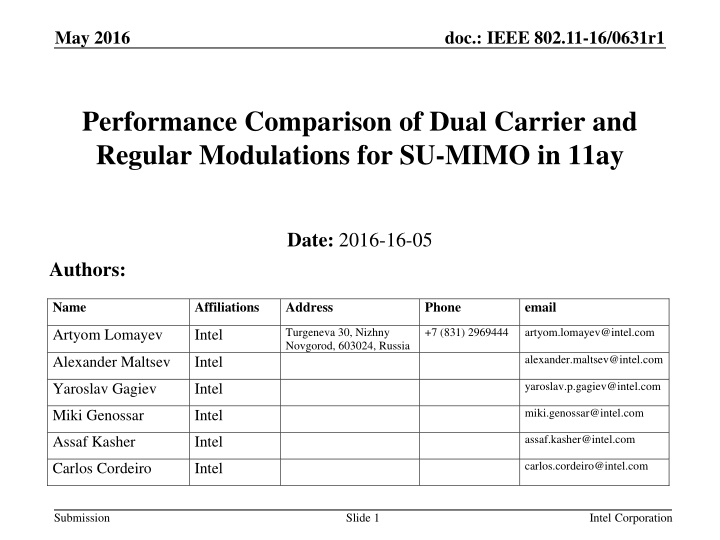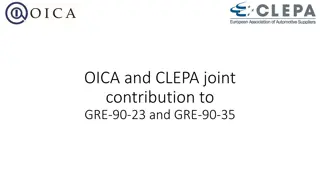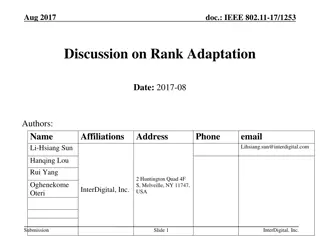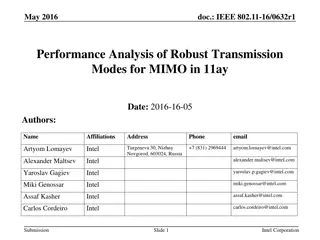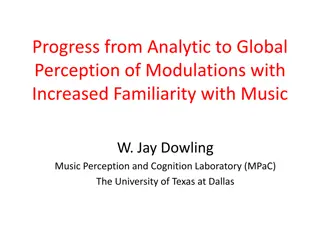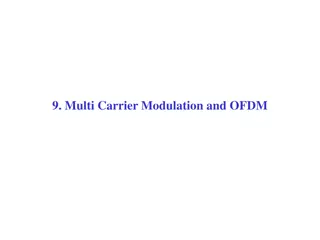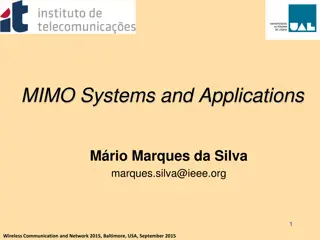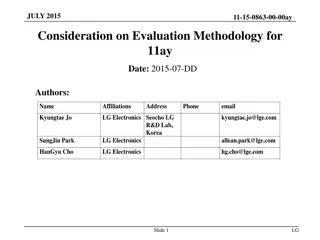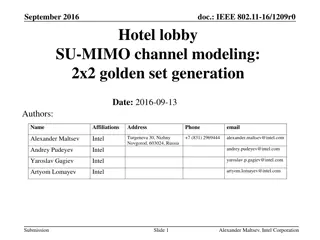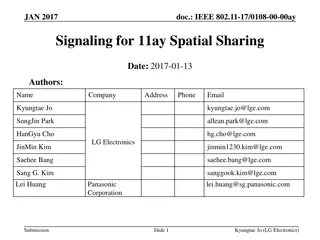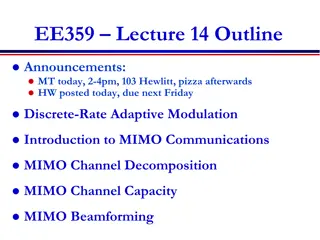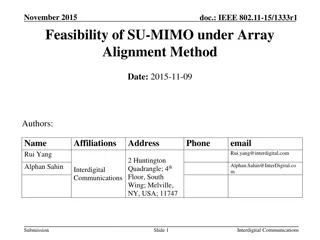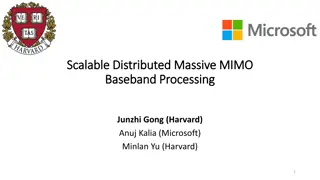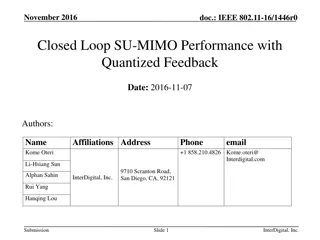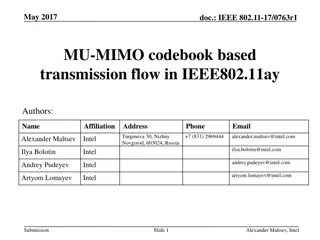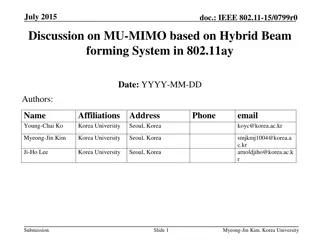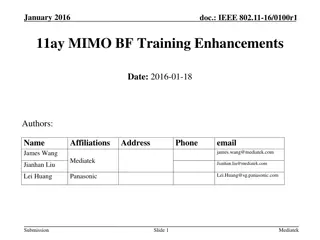Performance Analysis of Dual Carrier Modulations for SU-MIMO in 11ay
This work compares Dual Carrier Modulations (DCMs) with regular BPSK and QPSK modulations in the context of SU-MIMO systems. The analysis includes performance evaluation, implementation complexity assessment, and proposal of a space-frequency diversity scheme for DCM modulation. The study investigates modulations for the 11ad OFDM PHY, focusing on data rate equivalence and frequency-selective channel characteristics.
Download Presentation

Please find below an Image/Link to download the presentation.
The content on the website is provided AS IS for your information and personal use only. It may not be sold, licensed, or shared on other websites without obtaining consent from the author.If you encounter any issues during the download, it is possible that the publisher has removed the file from their server.
You are allowed to download the files provided on this website for personal or commercial use, subject to the condition that they are used lawfully. All files are the property of their respective owners.
The content on the website is provided AS IS for your information and personal use only. It may not be sold, licensed, or shared on other websites without obtaining consent from the author.
E N D
Presentation Transcript
May 2016 doc.: IEEE 802.11-16/0631r1 Performance Comparison of Dual Carrier and Regular Modulations for SU-MIMO in 11ay Date: 2016-16-05 Authors: Name Affiliations Address Phone email +7 (831) 2969444 Turgeneva 30, Nizhny Novgorod, 603024, Russia artyom.lomayev@intel.com Artyom Lomayev Intel alexander.maltsev@intel.com Alexander Maltsev Intel yaroslav.p.gagiev@intel.com Yaroslav Gagiev Intel miki.genossar@intel.com Miki Genossar Intel assaf.kasher@intel.com Assaf Kasher Intel carlos.cordeiro@intel.com Carlos Cordeiro Intel Submission Slide 1 Intel Corporation
May 2016 doc.: IEEE 802.11-16/0631r1 Introduction This work presents comparison analysis of Dual Carrier Modulations (DCMs) defined for the legacy 11ad OFDM PHY and regular BPSK and QPSK modulations providing the same data rate in application to the open loop 2 x 2 SU-MIMO scheme. The performance of the SQPSK and QPSK modulations transmitted using two subcarriers in the OFDM signal spectrum is compared to their regular BPSK and QPSK counterparts in frequency selective channel. Additionally implementation complexity of 2 x 2 SU-MIMO with DCM and regular types of modulations is compared. Based on the completed analysis a space-frequency diversity scheme is proposed for DCM modulation. Submission Slide 2 Intel Corporation
May 2016 doc.: IEEE 802.11-16/0631r1 System Configuration SISO system: DCM SQPSK and QPSK modulations, Static Tone Pairing (STP) subcarriers mapping; Regular BPSK and QPSK modulations, mapped to subcarriers without STP and any other interleaver type; 2 x 2 SU-MIMO system: Horizontal mapping: entire OFDM symbol is mapped to the 1-st or 2-nd stream; Modulation type is the same for both spatial streams; Submission Slide 3 Intel Corporation
May 2016 doc.: IEEE 802.11-16/0631r1 Channel Model In case of 2 x 2 SU-MIMO NLOS channel model is defined by 3D channel matrix as follows: : 1 = : 1 = = H , , , 0 : 1 i N j N k N , , i j k RX TX taps where NRX = 2 is the number of receiver antennas, NTX = 2 is the number of transmit antennas, and Ntaps is the maximum number of taps in the channel impulse response realization. Each Hij has exponential decay envelope in time domain with tRMS = 3 ns and independent distributed taps. The amplitudes of the taps are Rayleigh distributed and taps are taken at the sampling rate 2.64 Gsps. The total power of each Hij channel realization in time domain is normalized to unit power on instantaneous basis. The cross links are independent of the main links and have the same power as the main links. In case of SISO NLOS channel model includes H11 component only. Submission Slide 4 Intel Corporation
May 2016 doc.: IEEE 802.11-16/0631r1 Simulation Assumptions PPDU length 8192 bytes; LDPC uses LBP with min-sum approximation, maximum number of iterations per CW is 20; Number of simulated frames per SNR point is 105; Ideal channel knowledge, ideal acquisition, no RF imperfections; SISO: ML receiver; MIMO: ML or LMMSE receiver; Submission Slide 5 Intel Corporation
May 2016 doc.: IEEE 802.11-16/0631r1 SISO Performance Results ML receiver Solid line DCM, dashed line regular modulations; DCM SNR gain is defined for PER = 10-2 level, gain is larger for higher encoding rates; DCM SNR gain for SQPSK: MCS 13 1.8 dB, MCS 14 2.3 dB; DCM SNR gain for QPSK: MCS 15 0.7 dB, MCS 16 1.3 dB, MCS 17 2.0 dB; Submission Slide 6 Intel Corporation
May 2016 doc.: IEEE 802.11-16/0631r1 SU-MIMO Performance Results ML receiver Solid line DCM, dashed line regular modulations; DCM SNR gain is defined for PER = 10-2 level, gain is larger for higher encoding rates; DCM SNR gain for SQPSK: MCS 13 0.7 dB, MCS 14 0.9 dB; DCM SNR gain for QPSK: MCS 15 0.2 dB, MCS 16 0.5 dB, MCS 0.9 dB; Submission Slide 7 Intel Corporation
May 2016 doc.: IEEE 802.11-16/0631r1 SU-MIMO Performance Results (Cont d) LMMSE receiver Solid line DCM, dashed line regular modulations; DCM SNR gain is defined for PER = 10-2 level, gain is larger for higher encoding rates; DCM SNR gain for SQPSK: MCS 13 1.0 dB, MCS 14 1.4 dB; DCM SNR gain for QPSK: MCS 15 0.5 dB, MCS 16 0.9 dB, MCS 1.6 dB; Submission Slide 8 Intel Corporation
May 2016 doc.: IEEE 802.11-16/0631r1 Performance Summary Table 1: SNR gain in dB for dual carrier modulations over the regular counterparts for SISO and MIMO systems. MCS SISO MIMO ML 1.8 dB ML 0.7 dB LMMSE 1.0 dB 13 2.3 dB 0.9 dB 1.4 dB 14 0.7 dB 0.2 dB 0.5 dB 15 1.3 dB 0.5 dB 0.9 dB 16 2.0 dB 0.9 dB 1.6 dB 17 Submission Slide 9 Intel Corporation
May 2016 doc.: IEEE 802.11-16/0631r1 Implementation Complexity SQPSK DCM MIMO: Effective 4 x 2 channel matrix, considered for k-th and q-th subcarriers: S1, S2 QPSK symbols; ( ) ( ) ( ) k k k Y H H 1 11 12 ( ) ( ) ( 21 q ) ( 22 q ) k x k k k S S H Y H H 1 1 = 2 = 2 ( 2 ) 2 ( ( ) ) ( ( ) ) ( ( ) ) * * * ( ) q x ( ) ( ) q S S H Y H H 2 2 2 1 11 12 * * * ( ) ( 21 ) ( 22 ) q q q Y H H 2 ML receiver: MIMO system with NTX = 2 antennas can be effectively implemented using approach in [1]; ML receiver makes search over 2 * M hypotheses, for QPSK M = 4, total number is 8, so it has moderate complexity; Regular BPSK has smaller complexity, it requires 2 * 2 = 4 hypotheses; LMMSE receiver: LMMSE solution requires channel matrix inversion (HHH + 2I)-1, HHH is a 2 x 2 matrix, implementation complexity is similar to the MIMO with regular BPSK modulation; Submission Slide 10 Intel Corporation
May 2016 doc.: IEEE 802.11-16/0631r1 Implementation Complexity (Cont d) QPSK DCM MIMO: Effective 4 x 4 channel matrix, considered for k-th and q-th subcarriers: S1, S2, S3, S4 QPSK symbols; ( ) ( ) ( ) ( ) k k k k 2 2 H H H H S 11 11 12 12 1 ( 21 H ) ( 21 q ) ( 22 H ) ( 22 q ) k k k k 2 2 H H H H S 1 = 2 Y ( ) ( ) ( ) ( ) q q 2 2 H H S 5 11 11 12 12 3 ( 21 ) ( 21 ) ( 22 ) ( 22 ) q q q q 2 2 H H H H S 4 ML receiver: MIMO system with NTX = 4 antennas; ML receiver makes search over 2 * M(NTX-1) = 2 * 43 = 128 hypotheses; Regular QPSK has smaller complexity, it requires 2 * 4 = 8 hypotheses; LMMSE receiver: LMMSE solution requires channel matrix inversion (HHH + 2I)-1 per subcarrier, HHH is a 4 x 4 matrix; Regular QPSK requires 2 x 2 matrix inversion; Submission Slide 11 Intel Corporation
May 2016 doc.: IEEE 802.11-16/0631r1 Complexity Summary Table 2: Dual carrier and regular modulations implementation complexity for MIMO Modulation type Receiver operations Receiver complexity ML LMMSE ML LMMSE SQPSK DCM 8* 2x2** Moderate Low QPSK DCM 128 4x4 High High BPSK regular 4 2x2 Low Low QPSK regular 8 2x2 Moderate Low * - number of hypotheses in the ML exhaustive search ** - HHH matrix size for inversion in LMMSE solution Submission Slide 12 Intel Corporation
May 2016 doc.: IEEE 802.11-16/0631r1 Space-Frequency Diversity Scheme For SQPSK with 2x2 MIMO transmission it is proposed to use a space-frequency diversity scheme with mapping shown below. The 1st SPQSK symbol S0 is mapped to the 1st half of the spectrum to the 1st stream. Its conjugated repetition S0* is mapped to the 2nd half of the spectrum in the 2nd spatial stream. The proposed scheme extracts both space and frequency diversity gains. SQPSK Data block #1 336 symbols Data block #2 336 symbols Bits [2k, 2k+1] Bits [2k, 2k+1] S1 = conj(S0) S1 = conj(S0) s0 s0 Spatial stream #1 Spatial stream #2 168 subcarriers 168 subcarriers 168 subcarriers 168 subcarriers Data Data Data Data subcarrier P(k) subcarrier P(k) subcarrier k subcarrier k Submission Slide 13 Intel Corporation
May 2016 doc.: IEEE 802.11-16/0631r1 Conclusions MIMO with SQPSK DCM modulation exhibits performance gain of 0.7 0.9 dB for ML receiver and 1.0 1.4 dB for LMMSE receiver comparing to the regular BPSK modulation. MIMO SQPSK has reasonable implementation complexity comparable to the BPSK modulation. It is recommended to be used for MIMO transmission in frequency selective channels. MIMO QPSK DCM modulation exhibits performance gain of 0.2 0.9 dB for ML receiver and 0.5 1.6 dB for LMMSE receiver comparing to the regular QPSK modulation. However QPSK DCM has much higher implementation complexity comparing to the regular QPSK. It is not recommended for MIMO transmission. Submission Slide 14 Intel Corporation
May 2016 doc.: IEEE 802.11-16/0631r1 Straw Poll Would you agree to insert the following in section 7 of the SFD: The 11ay specification shall enable space-frequency diversity scheme for OFDM MIMO transmission using SQPSK DCM modulation with subcarriers mapping shown on slide 14. Submission Slide 15 Intel Corporation
May 2016 doc.: IEEE 802.11-16/0631r1 References 1. Y. Lomnitz, D. Andelman, Efficient Maximum Likelihood Detector for MIMO Systems with Small Number of Streams, Electronic Letters, October 25, 2007. Submission Slide 16 Intel Corporation
